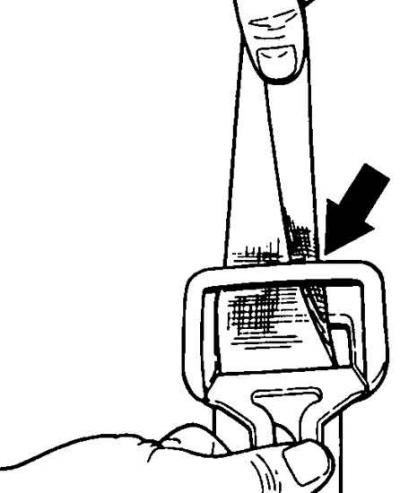Checking the seat belt for thread breaks or fraying

Warning: Do not use the power shoulder strap from the child seat emergency kit. The diagonal belt does not provide the necessary protection.
Belts, buckles and fastenings should be periodically inspected and checked for their serviceability. If belts are removed for any reason, they must be properly installed.
Warning: Keep the seat belts clean to ensure trouble-free operation of the tensioner. If the buckles or tensioning mechanism are damaged, replace the belts.
Warning: Belts that have been severely stretched in an accident should be replaced.
Warning: When exposed to sunlight and chemicals, the belt tape will lose strength. Loss of original color (fading) the belt should be replaced.
Warning: Wash belts in mild soapy water only. Dry the belts thoroughly before retracting them.
Warning: Do not chemically treat the belt webbing, tint it or discolor it. The compounds will weaken the belt. A belt that is discolored or chemically weakened should be replaced.
Warning: Belts should always be changed as a set. It is forbidden to install buckles and belt tensioners that are not designed for this seat, or from other vehicles.
Order of execution
1. Make sure the belts are not twisted as a result of improper installation. If the belts are twisted or bind when retracted, pull the belt out all the way to allow it to be straightened. Then return the belt to its original position.
2. Pull the belt out completely and release it until it retracts completely. If the belt sticks when moving in both directions, then check its cleanliness, the presence of dirt, grease and other foreign matter on the braid. The belt should only be washed with mild soapy water. If the belt cannot be flushed with this solution, it should be replaced.
3. Check the condition of all belt attachment points. The mounting bolts must be securely tightened. Remove any signs of corrosion where the belt attaches to the body. Replace the fastening parts affected by corrosion.
4. The belt should also be replaced if the following damage is found:
- thread breaks or fraying (see fig. Checking the seat belt for thread breaks or fraying),
- cuts on the loops on the edges of the belt,
- braid curvature,
- the presence of painted areas or cuts.
5. The belt assembly should be replaced if the following damage is found:
- the belt buckle is not secure enough,
- the belt release button is loose,
- the buckle does not release the belt,
- the force required to release the belt has increased,
- there are cracks on the surface of the buckle.

Visitor comments